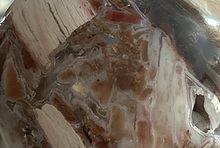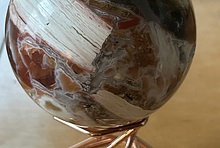Why pumice floats, then sinks
Last Updated: 21st Feb 2024By Ed Clopton

Children playing in pumice raft on fresh-water Lake Taupo, North Island, New Zealand. Photo: Rotorua Post, NZME / Dan Hutchinson
We all know about pumice, the frothy volcanic rock that floats on water. Scientists have long known that areas of floating pumice known as pumice rafts can remain on the surface of the sea for years and can travel thousands of miles before either sinking or washing ashore somewhere. Often pumice rafts are formed by undersea volcanic eruptions, and they may be the only indication that such an eruption has occurred.
What has puzzled scientists is why the pumice stays afloat for so long and then sinks. If the gas bubbles that give pumice its characteristic lightness are sealed—if it is a closed-cell foam—then it should float indefinitely until it washes ashore. And if pumice is an open-cell foam—if the cavities are mostly interconnected and are open to the outside—pumice should soak up water and sink quickly. Why does pumice float so long before it soaks up enough water to sink?
Scientists at the U.S. Department of Energy’s Lawrence Berkely National Laboratory used x-ray techniques to study the structure of pumice collected from several localities. They found that instead of having a mostly closed-cell structure, the pumice they studied was mostly open-celled. However, enough of the openings had the form of long, very thin tubes for the phenomenon of surface tension to play an important role in determining when a piece of pumice floats and sinks.
Surface tension is the interaction between a fluid and its surroundings that makes it behave as though it is contained by a thin skin, like a water balloon. Surface tension allows you to pour water carefully into a glass until it bulges up above the rim of the glass. Surface tension makes it harder for water to enter tiny openings. The “skin” seems to hold it back; it may even prevent the water from entering at all. Long-lived floating pumice has openings so small that surface tension prevents sea water from soaking into the cavities in the stone.
Then why does the pumice eventually sink? The researchers at Berkely Lab found that there are two forces at work—one, surface tension, that keeps the pumice afloat, and another that eventually makes it sink. The second force is diffusion. Gases tend to diffuse from areas of greater concentration to areas of lesser concentration. The gases that formed the cavities in the pumice gradually diffuse out into the sea water. Over time, loss of gas from the cavities by diffusion creates enough suction to overcome the resistance of surface tension that has kept water from entering the tiny cavities. Water finally is drawn into cavities, and when enough water is absorbed to make the pumice denser than the surrounding water, the stone sinks.
The behavior of pumice rafts is of interest to biologists and to the shipping industry as well as to geologists. Nutrient-rich pumice rafts are believed to play a role in distributing organisms around the globe, and the abrasive floating rock can damage engines that draw in sea water for cooling.
Originally published in the August 2017 monthly newsletter of the Maine Mineralogical and Geological Society.
References
Article has been viewed at least 668 times.















